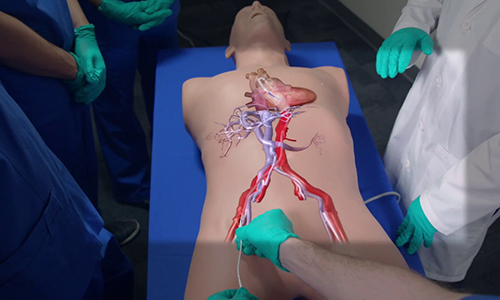Surgeons use Microsoft HoloLens to ‘see inside’ patients before they operate on them
February 9, 2018
Source: Microsoft
 981
981

Surgeons in the UK are using Microsoft’s mixed-reality headset to “see inside” patients before they operate on them.
A team at Imperial College London are wearing HoloLens devices in operating theatres so they can spot key blood vessels, bones and muscles, making procedures quicker and safer.
HoloLens allows the surgeons to take CT scans that have previously been completed and overlay 3D digital models of them onto a patient’s limb during reconstructive surgery.
The technique has been used to help surgeons successfully move blood vessels from one part of the body to another to help open wounds heal. Patients have included a 41-year-old man who injured his leg in a car crash, an 85-year-old woman who fractured her fibula and a person who developed an infection that required surgery.
Dr Philip Pratt, a Research Fellow in the Department of Surgery and Cancer at Imperial College London, said HoloLens is allowing surgeons to understand a patient’s unique anatomy very quickly and accurately.
“To perform the best operation, you have to plan it meticulously beforehand. This technology allows us to experience the data that we have collected from patients before their operation in the most realistic and natural way. You look at the leg and essentially see inside of it; you see the bones and the course of the blood vessels,” he said.
James Kinross, a consultant colorectal surgeon at St Mary’s Hospital who has used HoloLens during operations, agreed that seeing inside a patient could be crucial to the success of a procedure.
“You don’t want to make an incision and find out that you should be two centimeters over here, because that might compromise the operation. This is all about the best outcome for the patient,” he said.
Patients who have suffered an accident may have open wounds that require reconstructive surgery. Skin and blood vessels are taken from a healthy part of the body and used to cover the wound, enabling it to close and heal properly.
A vital step in the process is connecting the blood vessels of the “new” tissue with those at the site of the wound, so oxygenated blood can reach the area.
CT scans are conducted on the patient to map the limb before the operation begins. These are then uploaded to HoloLens, which places the images on top of the patient. Multiple surgeons wearing HoloLens headsets can also see what their colleagues are specifically looking at, allowing greater collaboration.
Surgeons have traditionally used a handheld ultrasound scanner to find vessels under the skin by detecting the movement of blood. However, this is very time-consuming and still requires some guesswork as to where the vessels are and their path through body tissue.
By DduRead more on
- 【EXPERT Q&A】What are the regulations and requirements for exporting medical devices to the European Union? September 5, 2023
- 【EXPERT Q&A】What is the procedure for registering medical devices for the Russian market? August 22, 2023
- Things to Know before Buying Newborn Baby Incubators March 31, 2022
- Portable Nebulizer Machine September 10, 2018
- PHYSIOTHERAPY TABLE September 7, 2018
your submission has already been received.
OK
Subscribe
Please enter a valid Email address!
Submit
The most relevant industry news & insight will be sent to you every two weeks.



